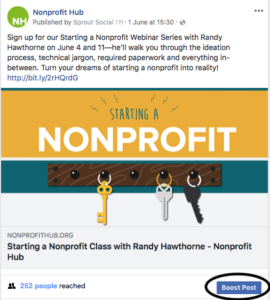How to Use Communication to Engage With Your Constituency
June 6, 2018
How and When to Boost Your Posts on Social Media
June 13, 2018The Ever-Growing Trend of Giving Days
Nonprofit Hub’s hometown, Lincoln, Nebraska, just had a record-breaking giving day bringing in $4.6 million to the nonprofit community. Just weeks before, my hometown of Hastings, Nebraska (population 25,000) raised nearly $500,000 in one day.
In the last decade this community giving phenomenon has swept the nation.
Giving days—what are those?
If you aren’t familiar with this concept, a giving day is when sponsors come together to host a 24-hour event where organizations and individuals focus on widespread fundraising, generally within a specific city or county. And this strategy has proven to work—we’re talking millions, here. In fact, New York City’s #NYGivesDay raised $15.7 million in just 24 hours in 2017.
So, why is this so effective? People can donate to nonprofits every day of the year, right? There are many factors at play here, but a combination of city-wide advertising and a sense of urgency, competition and community seems to be the key to why giving days have been, and continue to be, so successful.
Promotion
Aside from providing a platform for donations, giving days offer a lot of free advertising and promotion. The host organization wants the event to be as successful as possible in order to shine a good light on them. But in doing so, they’re all so providing free promotion for all participating organizations. It’s truly a win-win.
Giving days also provide your nonprofit with a great excuse to ask for money. It’s not annoying or desperate, either, because it’s all part of the larger event—it has context. Something along the lines of: “(Your city’s) giving day is soon! Come visit our booth to help the community unite for a greater cause!” will yield far better results than your individual organization asking for money out of the blue.
Urgency
Another reason giving days work so well is the sense of urgency they provide. In your social media posts and emails, you can use countdown tactics like, “Only a few more hours left until the end of our giving day!” This adds an element of time-sensitivity and makes people think the donation clock is ticking. Additionally, many giving day donations are matched by the host organization or an outside foundation. This adds yet another layer of urgency: if donors don’t get their money in by the end of the day, it won’t make as big of an impact. Playing off of this collective sense of urgency has proven very profitable by organizations participating in giving days.
Friendly competition
People, and especially passionate donors, are very competitive by nature, and giving days encourage a healthy competition among charities. Some cities even have live leaderboards that rank which organizations are out-fundraising others. If a donor is passionate about a cause, they’re going to do everything in their power to make sure the organization they care about is at the top of that leaderboard. Some nonprofits even promise prizes and benefits to their major donors once they reach a certain goal, which spurs more contributions as well.
All together now
Finally, giving days harness all the altruistic energy of the community into a cohesive, one-day event. People love feeling like they’re a part of something bigger, and these designated fundraising events create that feeling more than writing a check on a random day ever could. The energy of giving days is palpable. Donors feel valued, impactful and united with their city as a whole.
Whatever the reason for giving days’ effectiveness, the end goal is the same: to promote a community that is generous, engaged and committed to investing in its future. So, do some research and see if there’s a giving day in your city! And if there’s not, consider forming a coalition to start one—it’s an investment your community will cherish.
The post The Ever-Growing Trend of Giving Days appeared first on Nonprofit Hub.
